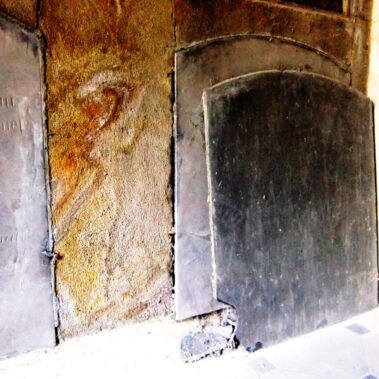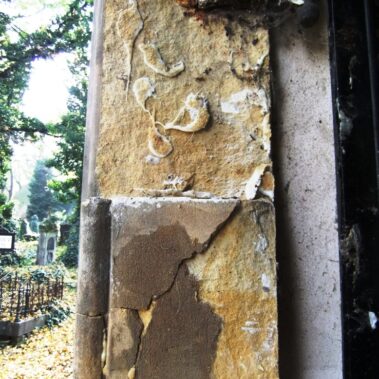Neo-Gothic Crypt of František Václav Pštross, Olšany Cemetery, Praha - Vinohrady - Žižkov, Czech Republic

| Address: | Hrobka Františka Václava Pštrosse, Hřbitov Olšany č. V-XXXIV |
|---|---|
| Description of work: | Restoration of stone architecture of the crypt (apex cross, escutcheon of
the entrance doors, selected elements of the interior) Repair of the roof of the side columbaria |
| Contractor: | GEMA ART GROUP a.s. |
| Implementation: | 10-12/2011 |
The Olšany Cemetery complex is the final resting place of nearly 2 million people. The number of the graves and the area it covers of over 50 hectares make it the largest burial ground in the Czech Republic. The oldest of its 12 cemeteries was founded in 1680 and was intended as a burial place for victims of the plague. Their number was so large that the existing smaller Prague cemeteries did not suffice.
The site chosen for the new burial ground, today located within the Olšany Cemetery, had been the property of the Prague Old Town municipality since 1558, when it was purchased from the nobleman Vilém of Hradešín. The chapel of St Roch and St Rosalia, patron saints against plague, also dates back to the 1680s. New outbreaks of plague occurred in 1713 and during 1771 and 1772, when the cemetery was further expanded. Until 1787 the Olšany burial ground had been called “The plague cemetery” and indeed until then only victims of the pestilence were interred there. This changed during the rule of the Emperor Josef II (1780 – 1790), who decreed a prohibition of burials in the centre of Prague. As a consequence the Olšany Cemetery was from then on used routinely for the internment of the deceased from the Old Town, Karlín, Žižkov and Strašnice districts of Prague.
In order to increase its capacity, the cemetery was enlarged many times during the 19th century. The chapel of St Roch and St Rosalia also gained in importance, when it was elevated to the status of parish church in 1847. The painting of “The Exaltation of the Holy Cross” was at the same time relocated to the chapel from the dilapidated original Olšany parish church of the Holy Cross.
The Olšany Cemetery is the last resting place of many luminaries of science, culture, art and politics. Among them are the writer Ladislav Čelakovský (1799 – 1852), the satirical poet Karel Havlíček Borovský (1821 – 1856), the linguist Josef Jungmann (1773 – 1847), the historian and co-founder of the fitness movement “Sokol” Miroslav Tyrš (1832 – 1884), the archivist and writer Karel Jaromír Erben (1811 – 1870), painter Josef Lada (1887 – 1957), actor and screen writer Jan Werich (1905 – 1980), anti-communist activist Jan Palach (1948 – 1969) and many others. Members of the World War I “Czech Legion”, the victims of the Prague Uprising of the 5th May 1945 and soldiers of the Red Army are all also buried there.
Many outstanding examples of funereal sculpture, work of well-known artists such as František Xaver Lederer, František Bílek and Jan Štursa, are to be found within the cemetery, mostly as parts of architecture and sculptural ornamentation of the crypts and tombs, of which there are around 25 thousand in the complex. The chapel-style crypts number two hundred and most valuable among them, as far as funereal art is concerned, are the Zenkl family crypt from 1799, the white marble crypt of the Hrdlička family with a sculptural group by the artist František Rous and the large Lann family crypt with sculptures by Josef Václav Myslbek and Ludvík Šimek and paintings by František Sequens.
The crypt of František Václav Pštross and his family is also of high artistic value. The crypt is built from Hořice sandstone and its author is unknown. It is designed as a chapel and is ornamented with moulded ledges and triangular pediments. It has an entrance portal and blind traceries on the columbaria. Each of the triangular pediments has a rosette window richly decorated with tracery. The top of the front pediment bears the carved inscription of the year 1868.
František Václav Pštross (1823 – 1863) was an influential local politician and member of the town council since 1848. He was also an owner of a prosperous tannery situated in Prague New Town and well regarded in commercial circles. He was a chairman of the Prague Commerce and Enterprise Chamber and from 1861 also the Mayor of Prague. During his time in office he was well known for promulgating the use of Czech language in the city’s administration – in November 1861 Czech was introduced as the official internal language in all departments. From 1861 to 1863, when Pštross was the Mayor, many Czech clubs, cultural institutions and societies were instituted, such as the choir “Hlahol”, the health and fitness movement “Sokol”, the society for the encouragement of Czech literature “Svatobor” and the important art club “Umělecká Beseda”. František Václav Pštross died suddenly in June 1863, a victim of meningitis.
The restoration work concerned the crypt of the Mayor of Prague František Václav Pštross, who died in the second half of the 19th century. The extent of the work was curtailed by budgetary limits. For this reason the restoration blueprint focused on the most valuable and most damaged parts of Pštross’s last resting place, a chapel-styled crypt.
The work concentrated on the restoration of the escutcheon of the entrance doors and the apex cross, and within the interior on the sandstone lining of the columbaria and the tombstones of the individual burial chambers. The flat roofs also required renovation and had been temporarily secured with asphalt tarpaper.
Restoration of the stone elements:
The crypt was built from Hořice sandstone blocks, which were in places weatherworn. The original tin waterspouts, which ensured the drainage of the structure, were not preserved and water seepage continues to affect the stone masonry and the surfaces. Some parts of the guttering were so full of detritus they completely lost their function. Pointing of the stone blocks had in places crumbled away. The stone escutcheons around the wrought metal doors were fractured due to the corrosion of the metal hinges. Stucco plastering inside the crypt was damaged by dampness and the walls were covered in algae. The slate tombstones were also affected by damp and one of them had in the past been replaced by a cement cover.
The stone was cleaned using a regulated steam jet. Gypsum crusts, which were also present, were removed using spatulas, scalpels and fine brushes. Unsuitable pointing repairs were removed using stonemasonry tools.
Consolidation of the stone using esters of silicic acid followed. Mineral based artificial grouts were used for repointing. The grouts were coloured with iron oxide pigments to harmonize the pointing visually with the stone. To conclude a hydrophobic treatment was applied to guard against the effect of the dampness. The slate tombstones were in addition treated with a special hydrophobic agent which would accentuate their original lustre.
Repair of the side roofs of the columbaria:
These flat roofs had been damaged several years ago and had been in the past covered with unsightly asphalt tarpaper, which was in turn covered with a layer of decaying leaves and branches.
Both these deposits and the tarpaper were removed and replaced with titanium-zinc roofing. The edges of the roofing purposely overlap the stone masonry, so that the draining water will not further damage the surface of the stone. The ends of the guttering were given new simple titanium-zinc spouts.
Otevírací doba na hřbitovech:
leden – únor 8:00 – 17:00
březen – duben 8:00 – 18:00
květen – září 8:00 – 19:00
říjen 8:00 – 18:00
listopad – prosinec: 8:00 – 17:00


























